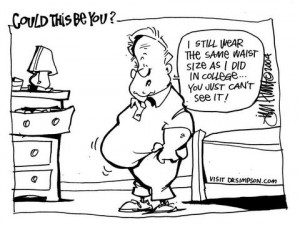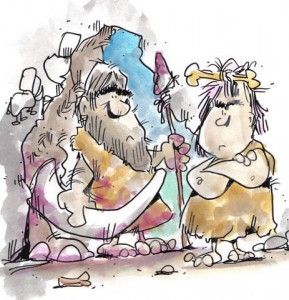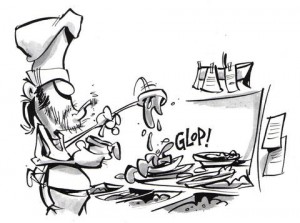In 2004 I published a book called “Losing the Last 30 Pounds: Fundamentals of Weight Loss.” The book was a hit, and we are going to be changing the cover -and updating some of the silly new diets that have come into vogue. The premise of the book, and how we look at diet and weight loss are still the same. Below is from a chapter about diets. You can still obtain the book from Amazon.com
A number of my patients, when deciding to get to their goal, ask, “Should I go back on Atkins or go to Weight- Watchers?” The answer is no, and the reason is simple:
Those are diets, not lifestyle changes. Sure, some of those do proclaim that they offer changes in lifestyle, in their own way, but they are really a diet. If diets worked, would we need weight loss surgery? Ask the famous question, “How does that work for ya?”

Often times we don’t know we gained the weight
Diets are a set of rules imposed on you by someone else. How do you respond to someone telling you what to do? I was in a restaurant a number of years ago while on the Atkins diet when they offered me some of their fresh bread. My response was, “No thanks, I am on Atkins.” It felt good to say that because I was following a rule-bound diet and doing a good job—but I missed the bread. I was following someone else’s rule for a diet that makes no sense. It is far better to adopt a healthy lifestyle with healthy choices.Those choices are not strange, they are simple.
The one food or one food group diet
The most famous diet, at least today, is the Keto diet. It has been almost universally tried by all of my patients and misunderstood, perhaps even by the Keto folks themselves. But the Keto diet is another version of the Atkins diet. Robert Atkins made a great deal out of the body going into “ketosis” where it burns fat instead of turning food into fat. He had a complicated set of theories. None was ever proven, in fact, the reason you lose weight on that, or any low carbohydrate diet is fairly simple: you eat less. The Journal of the American Medical Association published a study showing that the average consumption of calories in low-carbohydrate diets is much less than other diets, and hence they are successful at losing the weight.
I gained weight on Keto
—or, biology does not overcome the laws of physics
How can you gain weight on a diet that promises that you will lose weight if you avoid carbohydrates and eat meat? Because if you eat enough calories you will gain weight. Meat—or protein—contains calories, and your body is perfect at counting calories. Your body doesn’t care where the calorie come from, it will count every calorie even better than you will, and if you eat enough protein or fat, or drink enough alcohol, or eat enough carbohydrates, you will gain weight.
Most weight loss surgery patients have been on this dietor a variation of it and they know—given their pre-operative anatomy—that they really did gain weight on a diet, without cheating. After all, when you have a stomach that can hold a small mammal, you know you can eat your way into ketosis and weight gain on the Atkins diet. Simply put, a calorie is a calorie is a calorie. It doesn’t matter if you get the calorie from meat, from figs, from bread, or from alcohol. If you get a bunch of calories together you will store them, and if you store them, you will store them as fat. Eat enough steak and you will gain weight.
The Cavemen

The famous caveman diet- life wasn’t so simple
Then there is the old “when we were cavemen” theories. They show how back in the old days when men hunted the wooly mammoths, lived in caves, and didn’t shower, that they were thin (now how do they know we were thin?). Back in those days, as this theory goes, we ate meat (lots of it), and didn’t gain weight. Well, there were a few other things in “the good old days” that we might want to think about—the cavemen hunted to get their meat, which meant exercise. The cavemen had famines and for long periods couldn’t eat, and the cavemen didn’t have refrigerators to store the meat so when it went bad, it went bad. If you want to go on a caveman diet, or think that eating one thing will make you lose weight, think again. The body is designed to store excess food as fat, and the body doesn’t care if those excess calories come from donuts, wooly mammoths, prime rib, tofu, or corn—the body was built to withstand a famine.
Our biology was not designed to eat just meat or just vegetables but to eat a variety of food types. So were our taste buds. Give us a single food and we will get sick of it. Sure, we might have to eat the Wooly Mammoth to survive, but can you imagine the kids in the cave, “Ah come on, dad, Wooly Mammoth again? Can’t you go get a Saber tooth tiger?”
Okay, imagine living in a cave:
Husband comes home proudly dragging the dead Wooly Mammoth, “Honey, I am home, and brought dinner. Barbecue tonight.”
“Don’t drag that thing in here, I just cleaned the cave.”
“Okay, but help me cut these ribs.”
“Cut your own ribs, I have to feed the children their ribs first.”
Days later.
”Get that old carcass out of here, it smells, and while you are at it stop drawing on the cave wall and get us some more dinner.”
“But honey, that was the biggest one I got, I want to paint this on the cave wall for all to know what a great hunter I am.”
“You will be a hunter without a cave if you don’t get that smelly carcass out of here. Why can’t you stay home and plant like the other cavemen? Why do you have to go out and bring these dead animals home? Grog stays home, he plants, their family eats, and it is easier to throw out grain that is bad than that large ugly animal.”
“But we can keep warm with the skin, and it shows my skill as a hunter, and I can provide for the whole village. We grow fat on the wooly creature but their crops fail.”
“Speaking of fat, I think it is time you stop eating all that meat and go hunt some gazelles. At least you will get some exercise. You must have put on five pounds this week. And brush your teeth, all four of them.”
Variety can lead to excess
If you are given only a single food, even if it is a food that you like, you can eat only so much of it before you don’t want anymore. I love steak—put a 16-ounce steak in front of me and I will consume 10 ounces of it and bring the rest home for my dogs. After 10 ounces I am done with the steak, can’t eat anymore. So, if I am on a low carbohydrate diet, you can bet that I am done with dinner. But, if
I am not on that diet and you put a bunch of French fries with the steak, not only will I have my 10 ounces of steak, but also I will have eight ounces of fries and maybe even think about dessert. Let us not forget the glass of wine before dinner, the glass of wine during dinner, and the after-dinner drink (since we just called a cab).
Another example of getting sick is eating ice cream. There use to be an ice cream restaurant that had a dish called “the zoo.” If you could eat it, they would not charge you for it. Try to eat twenty scoops of ice cream, it isn’t easy. But you can do it if you eat a few saltine crackers with it. The variety of flavor (salt contrasting with the sweet) allows you to eat more. Again, variety can lead to excess.
Here is the problem—if with a single food diet you lose weight, when you add variety you are less likely to moderate the food that allowed you to lose that weight. In other words, you might think of steak as being “okay” because It is a diet food. You might be under the impression if you eat this food and expand your diet that this food won’t count for calories. Most of us know that too much red meat, with its fat, is not a healthy choice. However, seeing weight loss by eating steak leads one to think it is okay to have as much as you want because one incorrectly believes it is the carbohydrates, not the steak, which causes weight gain. But let’s just put that little theory to the calorie test:
One Steak—Porterhouse of course, 442 calories
French Fries, 154 calories
Salad with blue cheese dressing, 339 calories
One big slice of bread, 80 calories
One cup of broccoli, 77 calories
One real glass of wine, 127 calories

Fat is the most dense of all macronutrients
This meal was 1219 calories—and the majority came from things allowed on the Atkins diet (Steak and salad were 781 of the calories). Of the non-allowed items—the French fries, the bread, and the broccoli—you have just over 300 calories. Now, we are not advocating white bread or French fries at all—just pointing out the majority of calories from this meal come from the meat and the fat, not from the carbohydrates.
An Atkins lover would be inclined to add more fat, more meat, and less white bread. We like the less white bread, less fat, less processed foods, but adding red meat with fat is just not a great option. The point is simple: variety can lead to excess, or variety can lead to good flavors. However, single-food diets, while controlling calories, can lead to a false sense that these foods are “okay,” that they are “diet” foods. Fat is not a diet food.
Here is another example: If you get a cheeseburger and you substitute lettuce leaves for of the bun, you have a meal of 330 calories instead of 400 calories. The bun is just 70 calories! Yet so many people think they are helping themselves by eating something that is filled with fat (about 18 grams) and avoiding a bun. It is the calories that the body counts, not where they come from.
Single-food or food-group diets are simply a complex way to control portions. If you control portions then you will consume fewer calories. If you consume fewer calories then you will lose weight.
Surgery is the most radical of portion controls. Whether you had surgery and stretched your pouch, or your stomach has grown, if you limit portions, which is not difficult, you will lose weight. How much you lose is determined by the number of calories that you eat.
We do not like single-food diets for our patients because, more than anything, we want our patients to have a variety: you deserve a lot of fine tasting food and a variety of foods tends to have a variety of nutrients. Single-group diets are probably not going to work in the long run. They become a burden even if you like the food group you try. After a year on the Atkins diet, I couldn’t look at a steak, which was good, because I stopped the Atkins diet before I went to Europe at the height of the Mad Cow infestation.
